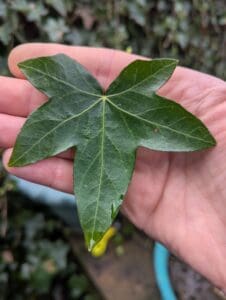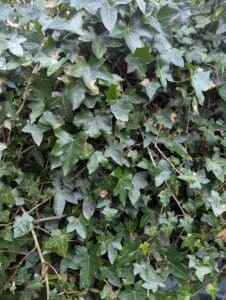Common Ivy / Spring / Summer /Autumn / Winter / Inedible
Welcome to our blog post all about the charming and versatile Common Ivy! Whether you’re a gardening enthusiast, a nature lover, or simply someone seeking to enhance their living space with a touch of greenery, Common Ivy has a lot to offer. In this post, we’ll delve into the fascinating world of Common Ivy, exploring its unique characteristics, medicinal and creative uses.
Get ready to discover the beauty and benefits of this timeless plant companion!
Common Names
Ivy, English Ivy, Atlantic Ivy, European Ivy, Common Ivy, Gum Ivy, True Ivy, Woodbind.
Botanical name
Hedera helix
Scientific Classification
Kingdom: Plantae
Order: Apiales
Family: Araliaceae
Physical Characteristics of Common Ivy
It is a climbing vine with glossy luscious leaves.
Leaves
Dark green and glossy with pale veins. Juvenile leaves have 3-5 lobes and a pale underside. Mature leaves are oval or heart-shaped without lobes.
Ivy is an evergreen plant, so leaves can be seen at any time of the year.
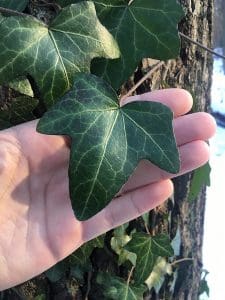
Flowers
September to November. Only mature plants produce flowers. They are yellowish green and appear in small, dome-shaped clusters known as umbels. Flowers of Common Ivy are typically larger, more rounded and with a more pronounced green tinge than those of Atlantic Ivy. Both species typically bloom in the autumn, but Common Ivy may bloom slightly earlier.
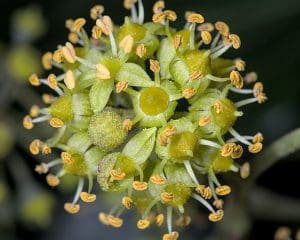
Fruit
The fruits are black, berry-like, and form tightly bunched, almost globular clusters. They each have a distinctive circle on the bottom, and ripen between November to January.
Not Edible.
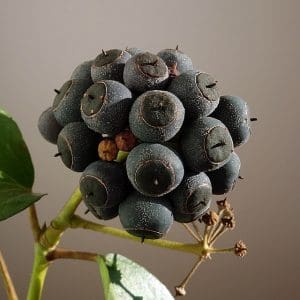
Stem
It has woody, climbing stems with specialised hairs which help it stick to surfaces as it climbs. It has two different forms: juvenile and mature and the mature forms can be self-supporting.
There was a potted Ivy plant in Gloucestershire that grew 300 feet long!
Ivy uses trees and walls for support, allowing it to reach upwards to better levels of sunlight. It is not a parasitic plant and has a separate root system in the soil and so absorbs its own nutrients and water as needed. Ivy does not damage trees and its presence doesn’t indicate that a tree is unhealthy.
Ivy Stems can be used to weave baskets. See Our Guide here
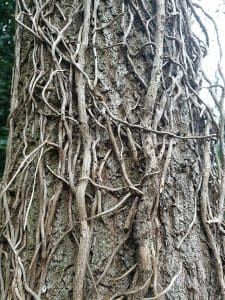
Habitat
Ivy is a common and widespread plant in the United Kingdom and Ireland. It can be found in many habitats, including woodland, scrub, wasteland, parks, gardens and on isolated trees. It is tolerant of shade and can survive in all but the most dry, waterlogged, or acidic soils.
Known Hazards
It can cause skin irritation for people with sensitive skin so it is advisable to forage Ivy with gloves on (I never do and have always been fine, but just in case!)
Common Ivy Could be Confused with
Poison ivy (Toxicodendron radicans)
Poison ivy is not common in the UK and not closely related to Ivy. It is a poisonous plant and can cause skin irritation.
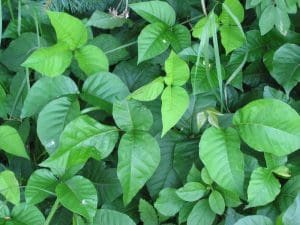
Atlantic Ivy (Hedera Hibernica)
Atlantic Ivy has leaves with 5-7 lobes unlike common ivy’s 3-5 lobes. The whole plant and also the berries are slightly poisonous. The fruits are similar to Common Ivy however Common Ivy’s fruits are typically larger and more glossy than the fruits of Atlantic Ivy.
It predominates in the west of Britain and in Ireland, as suggested by its common name.
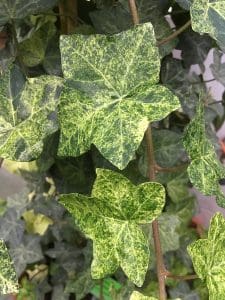
Edible Uses
None known.
Notes on Herbal uses
When taken orally
Common Ivy leaves were used medicinally in ancient Greece. Hippocrates used Ivy to prevent intoxication, reduce swelling, and as an anaesthetic.
Ivy is now being used by modern herbalists for its anti-inflammatory, expectorant, anti-arthritic, and antioxidant properties. Ivy may work to to alleviate respiratory disease in a number of ways. The extract and its main bioactive chemicals may lower muscle spasms in the bronchus (airways), may help with bronchodilation (the dilation of the airways in the lungs due to the relaxation of surrounding smooth muscle), and may aid secretolysis (breaking up mucus secretions in the airways). This might improve lung function in people with breathing difficulty. Ivy also may also lower inflammation and oxidation.
There are numerous research reports on Common Ivy’s antiviral action. For example, it may be effective against influenza ‘A’ virus and against enterovirus. Ivy may also be anti-bacterial, anti-fungal and anti-parasitic.
How to use Ivy as medicine
To treat a cough, Ivy leaves can be taken as a tea (finely chopped or ground, dried) using 0.5g of dried leaf (one teaspoon is 0.8g) per cup 1-3 x daily for up to 7 days. The tea tastes quite pleasant but it is most often taken as a tincture (the plant material extracted in alcohol), 1-3ml daily. It is also commercially available in capsule, syrup or cough drop form: take according to the label. To treat a chronic condition the specific prescription depends on the degree of breathing impairment, age and other factors so first consult a NIMH medical herbalist. Not for long term use without consultation. Do not exceed recommended dose.
Ivy cough drops and tinctures are also available to purchase from health food shops and online, all though it is such a common plant it should be easy to find.
When applied to the skin:
There isn’t enough reliable information to know if Common Ivy is safe when applied topically. It might cause side effects such as allergic skin reactions.
Extra notes from the Foragers
Ivy in Folklore
In Modern Neopagan interpretations of Celtic Mythology Ivy represents the 10th lunar cycle in the Celtic Ogham Tree Calendar from 30th September to 27 October. It is represented by the ogham symbol ‘G’ or Gort – a straight line intersected by two diagonals running left to right. Ivy is symbolic for this time autumnal time of year as it lives after its host plant dies, serving as a reminder that life goes on in an endless cycle of life, death and rebirth. According to legend this would have been considered a time to banish negativity from life and to reflect on self improvement, putting a barrier between the self and anything toxic.
In Celtic mythology Ivy also symbolises healing, protection, cooperation, the eternal binding together of lovers and is associated with good luck. It was believed that if ivy grew near a house, the members of the household would be protected from all evil.
In Roman mythology Ivy was associated with the god of revelry. According to Mrs Grieve (A Modern Herbal, 1931) “Ivy was in high esteem among the ancients. Its leaves formed the poet’s crown, as well as the wreath of Bacchus, to whom the plant was dedicated, probably because of the practice of binding the brow with ivy leaves to prevent intoxication, a quality formerly attributed to the plant. We are told by old writers that the effects of intoxication by wine are removed if a handful of ivy leaves are bruised and gently boiled in wine and drunk.”
Greek priests traditionally presented Ivy wreaths to newly-married couples and it was used in bridal bouquets by the Celts. It has long been regarded as the emblem of fidelity. Grieve adds that “the custom of decorating houses and churches with Ivy at Christmas was forbidden by one of the early councils of the church, on account of its pagan associations.” The plant was in fact sacred to the druids and considered the female counterpart to the masculine Holly.
Ivy and Wildlife
Ivy has long been accused of strangling trees, but it doesn’t harm the tree at all, and even supports at least 50 species of wildlife.
According to the Woodland Trust’s website ‘Nectar, pollen and berries of Ivy are an essential food source for insects and birds, especially during autumn and winter when little else is about. It also provides shelter for insects, birds, bats and other small mammals. The high fat content of the berries is a nutritious food resource for birds and the berries are eaten by a range of species including thrushes, blackcaps, woodpigeons and blackbirds.
Ivy is particularly important to many insects before they go into hibernation. Some of the main insect species which forage on the nectar and pollen of ivy are bees, hoverflies and common wasps.
It is an important food plant for some butterfly and moth larvae such as Holly Blue, Small Dusty Wave, Angle Shades and Swallow-tailed Moth.
Many rare insects are attracted to Ivy flowers, including the Golden Hoverfly.
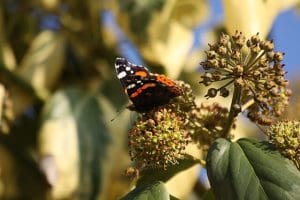
Using Common Ivy as a Detergent
The leaves from an Ivy plant contain high levels of saponin (Latin “sapon”, soap + “-in”, one of). Saponins extract from Ivy are used to make homemade laundry detergent. A simple way to do this is by crushing, bruising or chopping them up to release the saponin-rich sap. It is great for use on delicates and wool.
Ingredients
|
Method
To make a stronger laundry detergent which will be effective at cleaning really mucky and stained clothing and whiten your whites you can add baking soda and washing soda. |
References:
https://www.rxlist.com/supplements/english_ivy.htm
https://www.webmd.com/vitamins/ai/ingredientmono-465/english-ivy
https://ethicalbutcher.co.uk/blogs/journal/celtic-tree-month-of-ivy-30th-october-27th
Grieve, M. (Maud).(1931). A Modern Herbal; the Medicinal, Culinary, Cosmetic and Economic Properties, Cultivation and Folk-Lore of Herbs, Grasses, Fungi, Shrubs, & Trees with All Their Modern Scientific Uses. New York :Harcourt, Brace & company.



